Last time, I described Germany’s secret to abundant housing: financial rewards for localities. This time, I look at France’s recent success at filling greater Paris with more homes.
Metropolitan Paris is not yet a world leader in abundant, affordable housing in low-carbon neighborhoods. But it might be the most improved.
Paris is one of countless great cities that fell into the trap of residential lockdown—local NIMBY obstructionism stopping desperately needed homebuilding. What makes it remarkable is that it broke out again.
Most rich countries have watched their housing costs ratchet ever upward, as neighborhoods block infill homebuilding. Japan and Germany, my previous case studies, are exceptions, but they have always been exceptions: they never fell into the trap. Japan, because of its centralized government, and Germany, because its localities reap financial rewards from homebuilding, never stopped building in the first place. Prices and rents have therefore changed little.
Greater Paris is a typical rich-world place. Like Cascadian cities and most other great cities in industrialized democracies, it entered residential lockdown, with homebuilding slowing to a trickle. Unlike those other places, though, strong national and regional leadership allowed metropolitan Paris to burst through in the last dozen years and begin to build its way out of its housing shortage. It’s done particularly well at erecting homes in close-in suburbs, which are much more compact and low-carbon than its exurban periphery.
Paris’s success raises the tantalizing prospect that similar breakthroughs are possible elsewhere.
Paris housing
France has a middling record on housing costs in comparison with other advanced industrialized democracies. As the figure below shows, it’s not a paragon of housing-price stability like Germany or Japan, but its housing costs are not soaring like those in the United Kingdom and Canada. French housing-price trends are more comparable to those of the United States, where price averages are held down by the bifurcation of markets between expensive coastal metros and the cheaper sprawling Sun Belt and declining Rust Belt. French housing prices doubled in the decade before the international housing bubble popped in 2008. Thereafter, they essentially plateaued. The trends in house and apartment prices in greater Paris are similar: a doubling in the lead-up to 2008 followed by an uneven plateau. Recent data point to a pandemic price surge, as happened in most places, in conjunction with plummeting construction and interest rates.
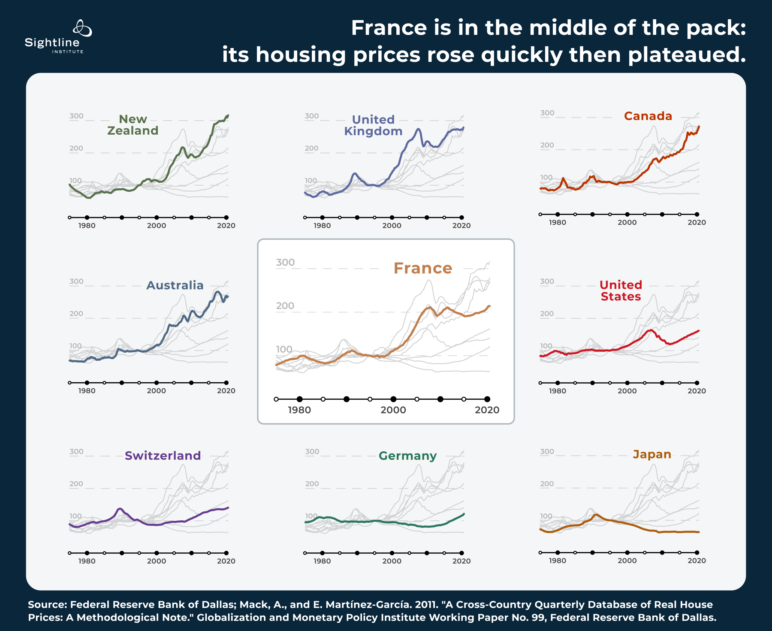 Everywhere, the homebuilding economy tends to be cyclical, booming and busting in response to macroeconomic trends such as interest rates. In France, construction mounted during the three decades after World War II to an all-time high in the early 1970s. During this period, the number of houses and apartments roughly kept up with the number of families seeking them. It helped that the national government-controlled land-use rules, as in Japan, so local obstructionism had little chance to interfere.
Everywhere, the homebuilding economy tends to be cyclical, booming and busting in response to macroeconomic trends such as interest rates. In France, construction mounted during the three decades after World War II to an all-time high in the early 1970s. During this period, the number of houses and apartments roughly kept up with the number of families seeking them. It helped that the national government-controlled land-use rules, as in Japan, so local obstructionism had little chance to interfere.
It also helped that real-estate development companies controlled by the national government were investing heavily in grands ensembles on the edges of cities. In 2015, George Packer described these subsidized complexes in the New Yorker as “colossal concrete housing projects built during the postwar decades, in the Brutalist style of Le Corbusier. Conceived as utopias for workers, they have become concentrations of poverty and social isolation.” Intended as stepping-stone housing for a growing middle class, they became dead ends instead. And because they house many of France’s Black, Arab, and Muslim residents, they are galling emblems of the nation’s imperfect realization of its motto: liberté, égalité, fraternité. Still, the grands ensembles were but a small part of the overall housing story in the postwar years, and they did flood the market with low-price apartments. In the greater Paris region—a super-municipal jurisdiction called Île-de-France that is home to about 12 million people—public and private builders erected homes of all shapes and sizes and roughly kept pace with national home construction.
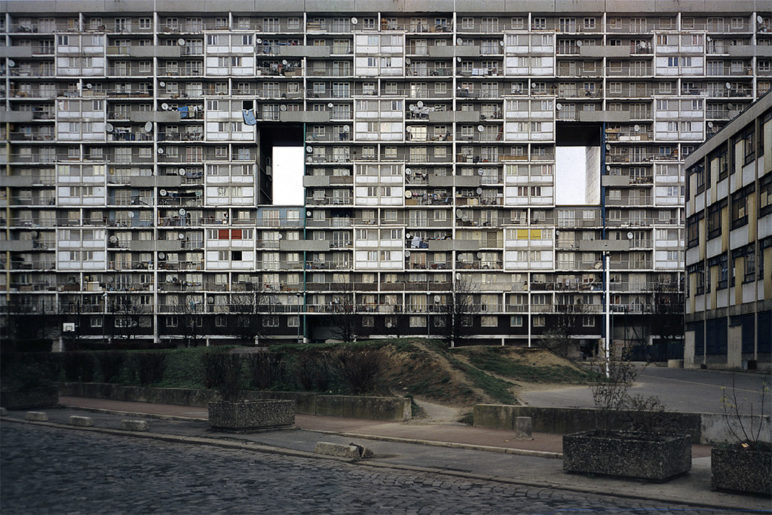
Cité des 4000, one of the grands ensembles constructed from the 1950s to 1980s. Image by Hadrien Sayf
All of that changed in the late 1970s and early 1980s, which brought both economic turbulence—the oil crisis, inflation, recession, slowed building—and decentralization of control over zoning and building rules. By the early 1990s, greater Paris—and its close-in petite couronne or “little crown” of nearby suburbs—had moved firmly into residential lockdown, with homebuilding lagging behind the national trend and greater Paris accounting for an ever-shrinking share of new homes. With about 20 percent of France’s population, it built less than 15 percent of new homes in 1992 and just slightly more than nine percent in 2006. (See: here, here, here.)
Nationwide, construction boomed again in the years leading up to the global financial crisis of 2008, mirroring most of the industrial world. Unlike in the postwar boom, though, greater Paris barely participated. As shown in the figure below, Paris walled out the boom, experiencing only a small rise and drop in apartment and house-building during these years. (The figure shows housing starts—the initiation of construction of new dwelling units, with seasonal variation smoothed by reporting 12-month cumulative totals each month from December 2000 to April 2021.)
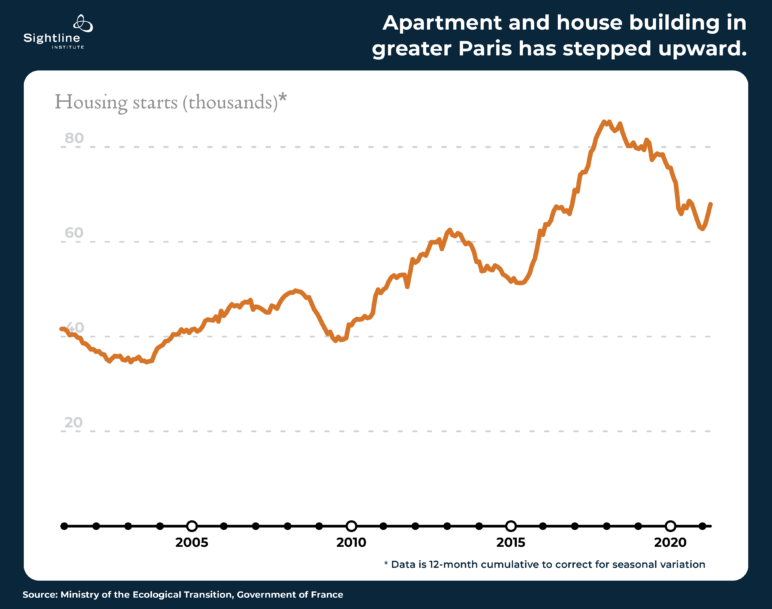 Up to 2008, Paris and France mirrored the pattern of English-speaking countries in the first figure. The principal cities were in residential lockdown, with most housing growth occurring in less-prosperous, less-sought-after locales. And just as in other Western countries, the rising cost of housing was exacerbating social divisions. Feargus O’Sullivan, writing in Bloomberg, describes “social segregation and a sense of disconnect between different communities in [greater Paris].” Richer, white, native-born people were congregating in the west, while poorer, darker skinned, and often immigrant residents became segregated in the east. Tanvi Misra notes, also in Bloomberg, that even terms of urban geography came to embody division: “the term ‘banlieue’ or ‘suburbs,’” she writes, “has become a euphemism for the racial other; these spaces embody the stereotypes that plague their residents, many of whom are working class immigrants of Middle Eastern and North African descent.”
Up to 2008, Paris and France mirrored the pattern of English-speaking countries in the first figure. The principal cities were in residential lockdown, with most housing growth occurring in less-prosperous, less-sought-after locales. And just as in other Western countries, the rising cost of housing was exacerbating social divisions. Feargus O’Sullivan, writing in Bloomberg, describes “social segregation and a sense of disconnect between different communities in [greater Paris].” Richer, white, native-born people were congregating in the west, while poorer, darker skinned, and often immigrant residents became segregated in the east. Tanvi Misra notes, also in Bloomberg, that even terms of urban geography came to embody division: “the term ‘banlieue’ or ‘suburbs,’” she writes, “has become a euphemism for the racial other; these spaces embody the stereotypes that plague their residents, many of whom are working class immigrants of Middle Eastern and North African descent.”
After the housing crash of 2008, as the figure above illustrates, greater Paris did something nearly unparalleled: it broke out of its homebuilding torpor. It began to build, build, and build some more. It doubled the number of housing starts between 2009 and 2018. By 2018, 20 percent of housing starts in all of France were located in Paris. For the first time in four decades, Paris was building in proportion to its share of national population. This building wave did not end the neglect or isolation of the grand ensembles, but it diluted their role by adding tens of thousands of new affordable dwellings integrated into more-prosperous neighborhoods.
And then the pandemic came, which brutalized Paris and sent homebuilding into a tailspin. Housing starts dropped from nearly 76,000 in the 12 months ending in January 2020 to under 63,000 in the following 12 months. However, in the first third of 2021 housing starts rebounded sharply—a hopeful sign.
National booms and busts still affect greater Paris, as the figure below illustrates. The inflection points on the national and regional lines mostly synchronize. But whereas greater Paris lagged badly in the early 2000s, it transformed itself into a leader after the 2008 crash. In the last dozen years, housing starts have stepped up substantially during each national housing-sector boom and fallen less substantially in each bust, including the recent pandemic-induced collapse in homebuilding.
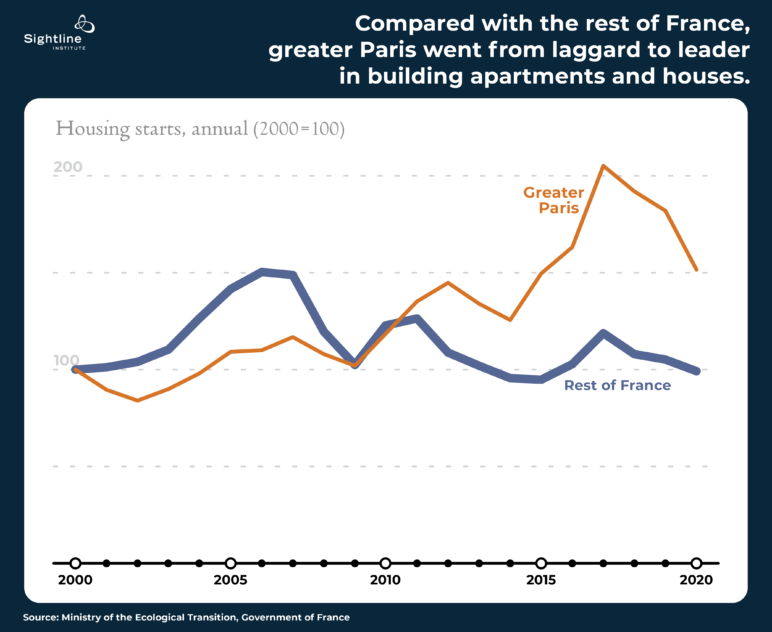 The costs of housing in greater Paris have moderated, thanks to its homebuilding surge. The average prices of apartments and houses doubled in the decade before the crash of 2008, when real-estate investment was booming, and greater Paris was boxing out construction. But by the time the after-effects of the crash had worn off, the Grand Paris initiative had accelerated homebuilding enough to hold average prices stable for years, even as the economy boomed. Unfortunately, a slackening in homebuilding after 2018 allowed prices to rise again, and the pandemic, which quashed construction, suppressed interest rates, and heightened demand for space, pushed them up steeply. Average rent per square foot in market-rate homes followed a similar path. It rose by three to five percent annually from 2001 until the 2008 crash, decelerated to below three percent until 2012 and then below one percent during the 2014-2018 surge of homebuilding. The lesson of the past decade is that if greater Paris can restore homebuilding to 2018 levels, it can probably flatten house and apartment prices again.
The costs of housing in greater Paris have moderated, thanks to its homebuilding surge. The average prices of apartments and houses doubled in the decade before the crash of 2008, when real-estate investment was booming, and greater Paris was boxing out construction. But by the time the after-effects of the crash had worn off, the Grand Paris initiative had accelerated homebuilding enough to hold average prices stable for years, even as the economy boomed. Unfortunately, a slackening in homebuilding after 2018 allowed prices to rise again, and the pandemic, which quashed construction, suppressed interest rates, and heightened demand for space, pushed them up steeply. Average rent per square foot in market-rate homes followed a similar path. It rose by three to five percent annually from 2001 until the 2008 crash, decelerated to below three percent until 2012 and then below one percent during the 2014-2018 surge of homebuilding. The lesson of the past decade is that if greater Paris can restore homebuilding to 2018 levels, it can probably flatten house and apartment prices again.
Greater Paris not only built a lot more homes, it built most of them in close-in neighborhoods. Such “infill” development is usually the hardest kind of housing to build, politically, because it involves construction in established communities full of neighbors with opinions and, often, power. But greater Paris achieved a remarkable turnaround. From 1975 to 2006, roughly the three decades before the housing crash, only 14 percent of new Île-de-France homes were in Paris and the petite couronne; the rest were in the outer, exurban ring, typically on greenfield sites. After the crash, the number of homes built in close-in neighborhoods soared: in recent years, half of all new dwellings in greater Paris have been in Paris and the petite couronne, most of them not in the city itself (which is already six times denser than Seattle) but in its closest suburbs.
How it happened
Greater Paris’s success is due to leadership, plain and simple, according to Yonah Freemark, a senior research associate at the Urban Institute in Washington, DC, who recently completed a close examination of French housing. Greater Paris had, writes Freemark, “a government-led attack on the housing-production problem.”
In 2007, housing shortages in greater Paris and the drag they imposed on the national economy convinced then-president Nicolas Sarkozy that greater Paris—the heart of the nation’s economy and cultural life—needed a bold new vision of infrastructure and investment. He called for a surge in homebuilding, an entirely new subway system, and a complementary economic development strategy. This vision came to be known as Grand Paris. Sarkozy, a right-leaning pragmatist, lost an election in 2012 to the socialist François Hollande, who was succeeded in 2017 by the technocratic reformer Emmanuel Macron. Remarkably, through each of these transitions—right, left, and center—the vision of Grand Paris survived, and although the details evolved, building much more housing remained an element.
Pressure from the national government generated prompt results, including a sharp post-2008 upturn in construction. Still, fully translating Grand Paris into laws, policies, and budgets took time. In 2010, the National Assembly set a goal for Île-de-France to build at least 70,000 dwellings a year, up from about 42,000 the previous year. In 2013, the Île-de-France government completed a plan to increase housing—it called for “massive and quality production” of housing— while emphasizing construction in existing neighborhoods and protection of green space.
This period witnessed a raft of other new policies. A national law in 2014 voided certain floor-area-ratio limits in local zoning codes, which unleashed construction of many small dwellings. Other national reforms trimmed the thicket of building code requirements that drove up construction costs. At the local and regional levels, governments made idle or underused public lots available for social housing. At the same time, greater Paris has been, as Bloomberg’s O’Sullivan writes, “pursuing some of the most enlightened and progressive transit policies of any megacity”—a massive transit expansion that is also removing highways, adding greenspace, and expanding bike- and walkways. The effort has logged impressive progress in reducing driving and increasing alternatives to it.
Social housing and the French state
France’s housing economy is an idiosyncratic product of its history and institutions. Compared with Cascadia—and with Canada and the United States in general, France has a highly centralized government, a vast welfare state, and a heavy reliance on quasi-public developers for housing construction. These facts bear on the lessons that Grand Paris can teach Cascadia and its peer regions. Let’s take them in turn.
Centralized. France is a unitary state, where all power resides in the national government unless specifically delegated elsewhere. Canada and the United States are federated republics, where national governments have limited powers. Consequently, the French President and Parliament exert much more control than their North American counterparts. The French Parliament, for example, sets building and land-use codes—local prerogatives in North America–although it delegates some powers to municipalities and regions. French local plans must coordinate with regional plans, which must win national approval.
Twelve years ago, then-President Sarkozy proposed encircling every new Grand Paris subway station with a mile-wide neighborhood of taller apartment buildings. Although the audacious proposal was rejected by Parliament, most localities are now implementing it anyway. Thus, 70,000 new homes are slated for construction within Sarkozy’s mile-wide station circles.
Centralization allows France not only to mandate housing rules but also to hold localities accountable for achieving housing goals. It can and does bring the hammer down on obstructionism. Local representatives of the national government can impose fines on localities, overrule local zoning plans that are too restrictive, or even seize land and transfer it to developers for additional housing construction. Such actions are rare, but the threat of them keeps most municipalities in line.
Welfare state. French housing is enmeshed in the large and generous French welfare state. France is a social democracy, not a North American–style individualist, liberal democracy. France spends fully 1.5 percent of gross domestic product (GDP) on housing subsidies for low- and moderate-income households: roughly six times as much as the United States, adjusted for GDP. In greater Paris overall, fully a third of dwellings are either social housing units or private units rented by tenants who receive cash rental assistance. The equivalent figure in greater Seattle is around five percent, according to Neil Kilgren of the Puget Sound Regional Council.
Since 1948, France has provided rental assistance to low- and moderate-income people as an entitlement, unlike US rental assistance, which depends on annual appropriations and barely covers one-quarter of those who qualify. In France, half of all renters benefit, and the assistance typically covers one-third to one-half of their rent, according to Arthur Acolin, a French scholar of housing at the University of Washington. France spends more than three times as much as the United States on rental assistance, adjusted for population. Unlike in the United States, the money goes directly into tenants’ bank accounts in most cases, not to landlords. It is based on their income and family size, but it is unrelated to their actual rent. In short, France does what Sightline has called for: it trusts people and gives them money.
France also spends vastly more than the United States on subsidizing the construction and maintenance of social housing—rental housing for low- and moderate-income families. Acolin notes that France has roughly as many social housing dwellings as the United States, despite having less than one-fifth the population. Nearly half of French rentals are in social housing buildings, and fully one-third of homes built in greater Paris over the last decade are social housing installed by private, public, or quasi-public organizations. Some of these homes are in grands ensembles, isolated from jobs and services, but most social housing built in the last two decades is inserted into existing neighborhoods.
Quasi-public developers. France relies much more heavily than the United States on public and quasi-public corporations to build housing. The role of these companies is important not only in construction but also in politics. Many developers in France are owned or controlled by national or subnational governments. These companies are governed by boards of directors made up of local elected officials and other representatives of civil society. They are funded in part by grants and loans from the national government. In greater Paris, publicly controlled developers built about one-fifth of new homes in recent years.
In Cascadia, localities write zoning rules and then wait for someone to show up and build things. In France, mayors and other leaders write local zoning plans even as they or their representatives, serving as board members of public housing authorities, design the structures that will put flesh on those plans. This system runs risks of self-dealing, but it yields a certain kind of accountability, as leaders must defend what they built when running for reelection. It’s a more streamlined type of democratic control of development than the project-killing gauntlets of consultation that Cascadian builders endure.
Inclusionary zoning à la française
Because French rental assistance is an entitlement, social housing well-funded, and construction often conducted by quasi-public firms, France can take a better approach to inclusion—integration by class, race, and ethnicity—than Cascadia. Inclusionary zoning in North America involves mandates that require private developers to provide quotas of discounted apartments to low-income households in each new building—an approach that can quash homebuilding and rarely produces many affordable homes. In contrast, France imposes its inclusion mandates not on developers or individual buildings but on entire cities. Most French cities are required to ensure that 20 or even 25 percent of dwellings—not new dwellings but all dwellings—are in social housing. By North American standards, those targets are gobsmackingly ambitious. Remember, barely five percent of greater Seattle dwellings are social housing.
To understand how 25-percent inclusionary zoning is possible, remember that nearly all localities have influence over quasi-public developers, have ready access to national funding for social housing, and can count on low- and moderate-income households to pay their rent thanks to rental assistance. Any locality that sincerely tries can hit the targets. The purpose of the national law is to ensure that every community helps integrate low-income households into neighborhoods. This rule is one reason for greater Paris’s recent success at boosting homebuilding in the petite couronne; it pushed every municipality to do its part.
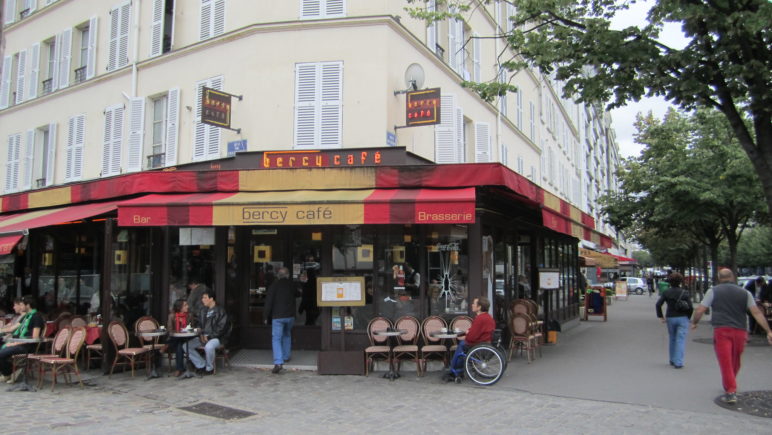
A neighborhood bistro in the growing Bercy district in Paris. Image by La-Citta-Vita on Flickr
The result has been to reduce the isolation of poor families. Whereas US metro areas tend to concentrate subsidized housing in central cities, French metros do not. At the turn of the 21st century, large French metropolises already had moderately well-distributed social housing, despite the many remaining grands ensembles erected before 1975. Since then, Île-de-France has further distributed social housing across its municipalities. Indeed, one study that Yonah Freemark coauthored finds greater Paris to be the best of nine world megacities at the geographic integration of social housing.
The lessons of Paris
Paris is something less than a model for places other than social democracies with centralized governments and quasi-public developers. But the brute fact of its housing transformation is inspiring nonetheless. It holds a powerful lesson.
Just 15 years ago, metropolitan Paris—the City of Light, a global symbol of cosmopolitan beauty and romance, the home since 2015 of climate hope—was as hogtied with obstructionist policies and politics as any great city in the world. Its pace of homebuilding was slower than it had been in the 1970s, when Paris had a much smaller, poorer, less educated, and less diverse population. Housing stock lagged further behind demand with each passing year. Increases in prices and rents dashed residents’ hopes and exacerbated displacement, exclusion, sprawl, and greenhouse gas emissions. The grip of residential lockdown was as stultifying in Paris and its banlieue as anywhere in the world, and nothing seemed likely to change those facts.
And yet something did change. Political leaders from the president on down said, “Enough!” (Well, they more likely said, “Assez!”) They overruled parochial obstructionism and implemented hundreds of policy changes. They were motivated by the goals of national unity; prosperity; opportunity for the next generations of citizens; integration by race, religion, and class; cleaner air and better lives; and the global climate.
As a result, the city of Paris doubled homebuilding, concentrated housing in low-carbon inner-ring suburbs, and distributed social housing across more of the metropolis than ever before. Thus, tens of thousands of people gained the chance to live in favored zones, with all the opportunities and amenities they offer. Thanks to France’s visionary leaders, the country’s showpiece city, Paris, is on its way to becoming the envisioned Grand Paris.
Paris is not yet the world’s best city for abundant housing in low-carbon neighborhoods. But leaders there—and their leadership was the key—likely made it the most improved. And that is a title worth vying for. If Paris could do it, why not we?
Next time: Stirrings for abundant housing in the English-speaking world.

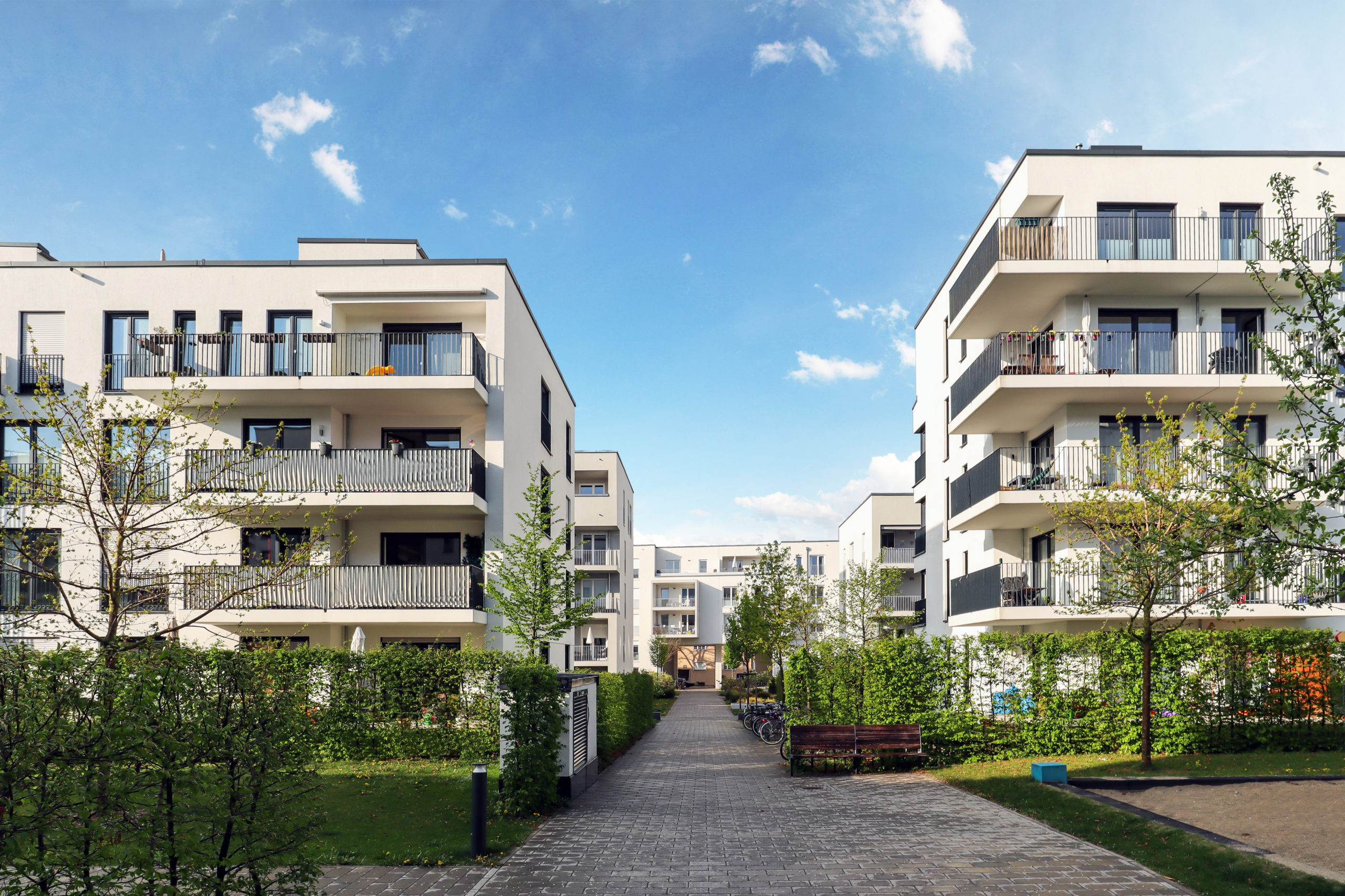
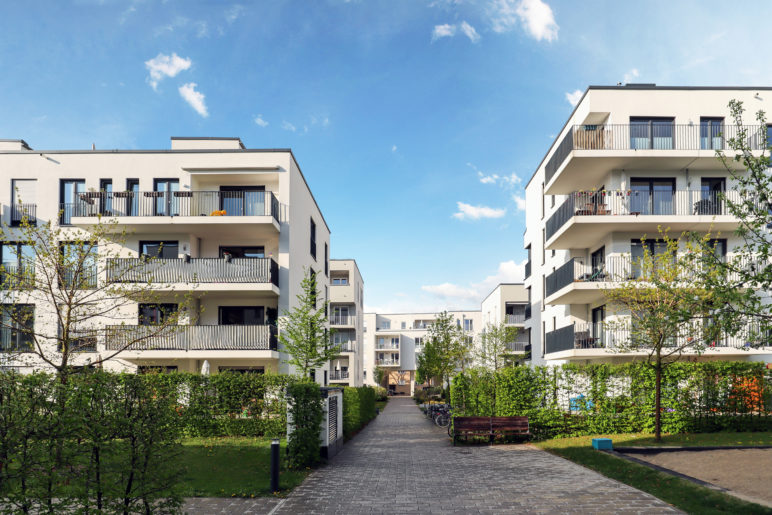







Kim Dobson
One point to be made , All of this housing is “Market rate” and so called ” Middle Income” accessible at the same time which is nonsense as we can see with the current Market Rate Inflation going on . No where in the Missing Middle does the zoning density legislation address mandates for low income housing and shortages of affordable $1200 apartments for the poor and elderly on fixed income . This fact has pleased industry groups like the Master Builders very happy because they maintain building affordable housing for low income people is unprofitable . This is also why Chamber of Commerce types in the legislature from both Republican and Democratic supported this “Buy Partisan” Missing Middle legislation and got it passed in Oregon and Washington HB 1923 and HB 2343. Let’s be honest , this legislation in Oregon and Washington is a clear gift to Speculators and Private Equity investor types . Yours , Kim Dobson , Radio Host at the Evergreen State college ,Member Thurston County Progressives ,TCD PCO 094 Thurston County Wa , Activist for low income housing and strong environmental laws SEPA ,EIS and Shoreline Management Act . PS your editors have in the past refused to print my letters because I disagreed with the article author’s content we will see how open minded the current “tone police ” are ?